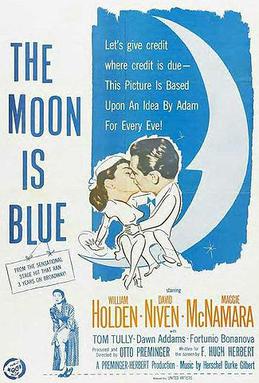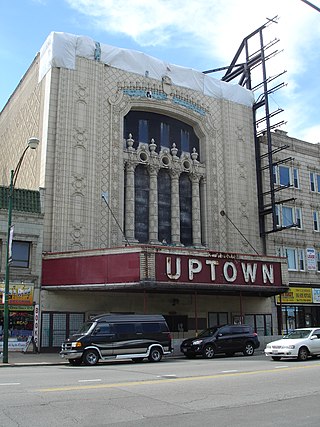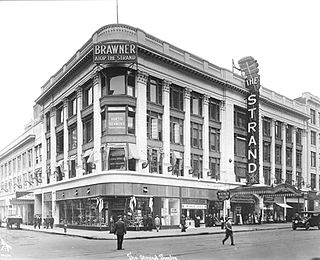
The Moon Is Blue is a 1953 American romantic comedy film produced and directed by Otto Preminger and starring William Holden, David Niven, and Maggie McNamara. Written by F. Hugh Herbert and based on his 1951 play of the same title, the film is about a young woman who meets an architect on the observation deck of the Empire State Building and quickly turns his life upside down. Herbert's play had also been a huge success in Germany, and Preminger decided to simultaneously film in English and German, using the same sets but different casts. The German-language film version is Die Jungfrau auf dem Dach.
The Blue Mouse Theatre title was used for several historic vaudeville and movie venues opened by John Hamrick in the Pacific Northwest of the United States. The name may have been inspired by a lounge in Paris. Hamrick is said to have used the colored rodential title for his first theatre in each city.

The Chicago Theatre, originally known as the Balaban and Katz Chicago Theatre, is a landmark theater located on North State Street in the Loop area of Chicago, Illinois. Built in 1921, the Chicago Theatre was the flagship for the Balaban and Katz (B&K) group of theaters run by A. J. Balaban, his brother Barney Balaban and partner Sam Katz. Along with the other B&K theaters, from 1925 to 1945 the Chicago Theatre was a dominant movie theater enterprise. Currently, Madison Square Garden, Inc. owns and operates the Chicago Theatre as a performing arts venue for stage plays, magic shows, comedy, speeches, sporting events and popular music concerts.

The Apollo Theater Chicago was built in Chicago's Lincoln Park neighborhood in 1978, by theatre producers Jason Brett and Stuart Oken. Located at 2540 N. Lincoln Ave., the Apollo has 430 seats and a lobby featuring art exhibits and a full bar. The theatre is also the home of the Emerald City Theatre Company. The Apollo Theater Chicago has no relation to the Apollo Theater in New York City.

Uptown Theatre is a currently closed movie palace and concert venue located in the Uptown neighborhood of Chicago, Illinois. Designed by Rapp and Rapp and built by Paschen Bros. contractors, it is one of the many movie palaces built by the Balaban & Katz theatre chain run by A. J. Balaban, his brother Barney Balaban, and their partner Sam Katz.

108 North State Street, also known as Block 37, is a development located in the Loop community area of downtown Chicago, Illinois. It is located on the square block bounded clockwise from the North by West Randolph Street, North State Street, West Washington Street and North Dearborn Street that is known as "Block 37", which was its designated number as one of the original 58 blocks of the city. Above-ground redevelopment is complete, but work stopped on an underground CTA station when the station was only partially complete.

The Paramount Theatre was a 3,664-seat movie palace located at 43rd Street and Broadway on Times Square in New York City. Opened in 1926, it was a showcase theatre and the New York headquarters of Paramount Pictures. Adolph Zukor, founder of Paramount predecessor Famous Players Film Company, maintained an office in the building until his death in 1976. The Paramount Theatre eventually became a popular live performance venue. The theater was closed in 1964 and its space converted to office and retail use. The tower which housed it, known as the Paramount Building at 1501 Broadway, is in commercial use as an office building and is still home to Paramount Pictures offices.

The James M. Nederlander Theatre is a theater located at 24 West Randolph Street in the Loop area of downtown Chicago, Illinois. Previously known as the Oriental Theatre, it opened in 1926 as a deluxe movie palace and vaudeville venue. Today the Nederlander presents live Broadway theater and is operated by Broadway In Chicago, currently seating 2,253.

The Warner Theater is a historic Art Deco movie theater at 147 High Street in downtown Morgantown, West Virginia, United States. Opened June 12, 1931, it was designed by architect John Eberson, whose theaters included the since-demolished Colonial and Astor in Philadelphia, Pennsylvania, the Calvert in Washington, D.C., and the Capitol in Chicago, Illinois; and the extant Cinema le Grand Rex in Paris, France, the Capitol in Sydney, New South Wales, Australia, the Dixie in Staunton, Virginia, and the American in The Bronx, New York City. Built at a cost of $400,000, about $5 million today, it featured a 50-foot vertical marquee illuminated with over 6,000 light bulbs of different colors, though the vertical marquee has since been removed, and many of the original light bulbs on the rest of the marquee were replaced with neon strips.

An atmospheric theatre is a type of movie palace design which was popular in the late 1920s. Atmospheric theatres were designed and decorated to evoke the feeling of a particular time and place for patrons, through the use of projectors, architectural elements and ornamentation that evoked a sense of being outdoors. This was intended to make the patron a more active participant in the setting.

The Harris and Selwyn Theaters are twin theatres located in the Loop community area of Chicago, Illinois. They were built by Sam H. Harris and Archie and Edgar Selwyn. They were designated a Chicago Landmark on March 31, 1983. They have been redesigned by the Goodman Theatre, which is located in them.

The Strand Theatre was an early movie palace located at 1579 Broadway, at the northwest corner of 47th Street and Broadway in Times Square, New York City. Opened in 1914, the theater was later known as the Mark Strand Theatre, the Warner Theatre, and the Cinerama Theatre. It closed as the RKO Warner Twin Theatre, and was demolished in 1987.

The Gramercy Theatre is a music venue in New York City. It is located in the Gramercy neighborhood of Manhattan, on 127 East 23rd Street. Built in 1937 as the Gramercy Park Theatre, it is owned and operated by Live Nation as one of their two concert halls in New York City, the other being the nearby Irving Plaza.

The Palace Theater is a 1925 movie theater, now closed, located at 791 Broadway in Gary, Indiana, in the city's Emerson neighborhood. It was designed by the prominent movie palace architect John Eberson.

The Broadway Theater District in the Historic Core of Downtown Los Angeles is the first and largest historic theater district listed on the National Register of Historic Places (NRHP). With twelve movie palaces located along a six-block stretch of Broadway, it is the only large concentration of movie palaces left in the United States. The same six-block stretch of Broadway, and an adjacent section of Seventh Street, was also the city's retail hub for the first half of the twentieth century, lined with large and small department stores and specialty stores.
The United Artists Theatre was a popular movie theatre located in the Chicago Loop. It was built as a live venue called the Apollo, then later turned into a cinema. It was demolished in 1989.

The Sun-Ray Cinema at 5 Points, formerly known as Riverside Theater and 5 Points Theatre, is a historic two-screen movie theater in Jacksonville, Florida. The first theater in Florida equipped to show talking pictures, it opened in March 1927 in the Five Points district of the Riverside and Avondale neighborhood.

The Davis Theater, originally known as the Pershing Theater, is a first run movie theater located in the Lincoln Square neighborhood of Chicago. Built in 1918, the theater has operated in different capacities in its history, showing silent films, German-language films, and various forms of stage performance. In 1999, the Davis was planned to be demolished to build residential condos, but the plans were cancelled in part due to a negative response from the community. It is one of the few operating neighborhood movie theaters in Chicago. Its building was listed on the National Register of Historic Places in 2016.

The Oregon Theatre, or Oregon Theater, was an adult movie theater in the Richmond neighborhood of southeast Portland, Oregon, United States. The theater was completed in 1925 and originally housed a Wurlitzer pipe organ and vaudeville stage. It would later screen Hollywood, art-house, and Spanish-language films. The building was acquired by the Maizels family in 1967 and became an adult cinema in the 1970s. It continued to operate as the city's longest running pornographic cinema and remained owned by a member of the Maizels family until 13 February 2020, when it went into foreclosure. It closed in early March 2020.

The Coliseum Theatre was a cultural and performing arts center located at 4260 Broadway between West 181st and 182nd Streets in the Washington Heights neighborhood of Manhattan in New York City. It was full-block building, bounded on the east by Bennett Avenue.




















